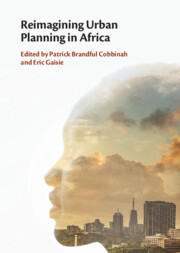Book contents
- Reimagining Urban Planning in Africa
- Reimagining Urban Planning in Africa
- Copyright page
- Contents
- Contributors
- Foreword
- Preface
- Acknowledgements
- Abbreviations
- Part I Understanding Sustainable Urban Planning in Africa
- Part II Case Studies on Urban Planning in African Countries
- Part III Sustainable Urban Planning in Africa
- 14 On the Need for Sustainable Digital Urban Infrastructure in Twenty-First-Century South African Cities
- 15 The South African Landownership Struggle
- 16 The 2030 Agenda, Climate Urbanism and Urban Planning in Zimbabwe
- 17 Urban Planning and Quality of Life of Urban Residents in Africa
- 18 Realising Rights in Complex Informal Settlements Contexts
- 19 Participatory Design Won’t Fix Unequal Southern African Cities
- 20 Enabling Smart Mobility in African Cities
- 21 On the Future of Urban Planning in Africa
- Index
- References
20 - Enabling Smart Mobility in African Cities
A Critical Perspective from South Africa
from Part III - Sustainable Urban Planning in Africa
Published online by Cambridge University Press: 07 December 2023
- Reimagining Urban Planning in Africa
- Reimagining Urban Planning in Africa
- Copyright page
- Contents
- Contributors
- Foreword
- Preface
- Acknowledgements
- Abbreviations
- Part I Understanding Sustainable Urban Planning in Africa
- Part II Case Studies on Urban Planning in African Countries
- Part III Sustainable Urban Planning in Africa
- 14 On the Need for Sustainable Digital Urban Infrastructure in Twenty-First-Century South African Cities
- 15 The South African Landownership Struggle
- 16 The 2030 Agenda, Climate Urbanism and Urban Planning in Zimbabwe
- 17 Urban Planning and Quality of Life of Urban Residents in Africa
- 18 Realising Rights in Complex Informal Settlements Contexts
- 19 Participatory Design Won’t Fix Unequal Southern African Cities
- 20 Enabling Smart Mobility in African Cities
- 21 On the Future of Urban Planning in Africa
- Index
- References
Summary
This chapter discusses smart mobility in sub-Saharan Africa to provide insights into (i) the history and relevance of smart mobility in its cities; (ii) empirical cases of smart mobility experiences in selected cities; and (iii) the potential of smart mobility in advancing urban planning reimagination in this region. Cities of South Africa were used as cases to demonstrate the importance of smart mobility in urban planning reimagination. Findings indicate that smart mobility is a new concept in sub-Saharan Africa and is in its nascent state. There are multiple barriers to smart mobility, including lack of integrated transportation, lack of investment by municipalities, lack of non-motorised transportation, the economic constraint of people, the demographic character and social and cultural behaviour of people. The cities also possess significant potential for the adoption of smart mobility. However, smart mobility might bring challenges to the built environment by influencing it through the transformation of the transportation system and urban spatial morphology. The resolution of the issues related to these two transformations remains vital for the creation of smart mobility and consequently smart cities. Therefore, urban planning should be reimagined for the transformation of the transportation system and the built form of the cities.
Keywords
- Type
- Chapter
- Information
- Reimagining Urban Planning in Africa , pp. 372 - 389Publisher: Cambridge University PressPrint publication year: 2023



